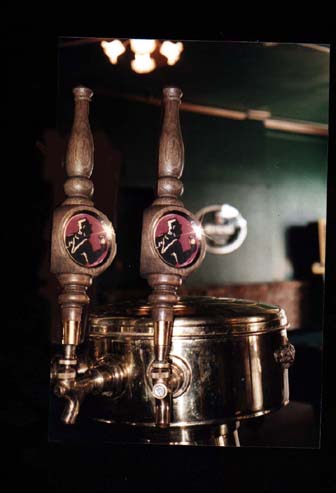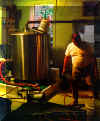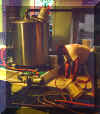|
A BRIEF HISTORY AND OVERVIEW
OF BREWING AND
BREWING IN SYRACUSE
The beer industry is a large part of the history of
Syracuse. Dating back to the 1850’s, immigrants from
Germany, England, and Ireland brought their brewing
skills to their new home. Syracuse soon became the
brewing capital of upstate New York. Over 2 dozen
breweries produced beer for local consumption, as well as
a market that ranged from Binghamton to Watertown, and
Rochester to Utica.
The Greenway Brewery, which once stood where Niagara
Mohawk now resides was the largest brewery outside of New
York City. Greenway also had the largest brewery sales
outside of Central New York. An estimated 100,000
thousand barrels per year were exported as far away as
China.
Prohibition killed off many local breweries which lasted
from January 16, 1920 to December 5, 1933. In an attempt
to stay alive, area breweries tried producing soda,
spring water and near beer, which contains 1/2 of 1%
alcohol by volume. Among the breweries which made a
comeback by 1933 were the Haberle Congress Brewing Co.,
Zett’s Brewery, Bartles Brewery, and Moore and Quinn
Brewery just to name a few. By the 1960’s all
breweries in Syracuse were out of business, and with
their demise a large part of the Syracuse culture was
lost. After a 32 year hiatus, commercial brewing was
restored to Syracuse with the establishment of The
Syracuse Suds Factory.
The beers and ales which we enjoy today are made with the
same ingredients used through the ages: malted barley and
other grains, hops yeast and water. The process expressed
in its simplest terms, begins with “malting.”
Only the choicest of grains are selected by the maltser.
Cleaned raw barley is steeped in water and germinated and
sprouted, dried slowly, and finally, roasted to produce
malted barley, This process awakens the grain’s own
enzymes which will later convert the grain’s starch
to sugar in the next step called “mashing.” Mashing styles vary, however, in essentially all the
malted grain is crushed in mills, mixed with water, and
heated for selected times at carefully chosen
temperatures. This produces a very sweet sugar solution
which, after filtration to remove solid grain residuals,
is called “wort.”
Next, the wort is transferred to the brew kettle where it
is boiled with the addition of hops. Boiling sterilizes
the wort, causing some unwanted grain protein factions to
separate and impart to the wort the delicate refreshing
bittering substances from the hops. After boiling, the wort is cooled, aerated, and mixed
with an amount of selected ale or lager yeast while being
transferred to a fermenter for “ primary”
fermentation. The primary, or main fermentation, takes
about one week at carefully controlled temperatures.
During the fermentation the yeast metabolizes the wort
sugars, proteins, and trace nutrients to produce alcohol,
carbon dioxide gas, and small amounts of a multitude of
delicately flavored materials which contribute to the
full character of the product. During all fermentation
phases temperatures are carefully controlled with some
final fermentations lasting three weeks and others as
long as six months or more, depending on product type.
Some finished products will contain a desired small
amount of suspended yeast, while others will be
“bright” filtered to remove yeast, as is the
characteristic of the beer style.
The brewing process equipment which you may observe in
our brew room consists of a brew kettle, three fermenters, heat exchanger
(wort cooler), water filter,
and fermenter temperature control system. Not observable,
but below ground level, we maintain our cellaring
operation which contains coolers, finish beer tanks, beer
filters, keg washing, filling equipment, and extensive
finished product storage.
To enables us to brew the widest possible selection of
beer and ale styles, we have chosen to brew with
concentrates of wort of exceptional quality, which have
been custom prepared for us at both domestic and European
mashing facilities. This allows us to escape technical
limitations of a single fixed mashing operation. We also
use the finest available domestic and European hops
varieties. Some of the hops are grown right here in
Central New York. The select ale and lager yeast strains
we use are also from European and domestic sources.
We truly hope that you enjoy our beers and ales and savor
the great care and pride that go into producing these
fine fine products.
Norman Soine
Syracuse Suds Factory
Brewmaster |
|
![]()

![]()


